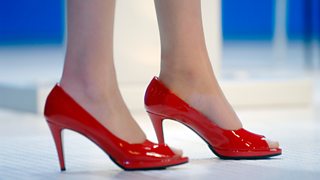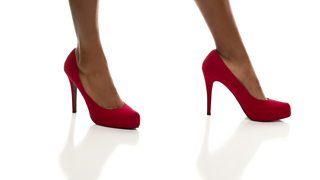Nine show-stopping facts about high heels
In The Origins of Stuff, comedian Katy Brand explores the eclectic life of the high heel – from the battlefields of 17th century Persia to the court of King Louis XIV; as a prop in pornographic photography and a red-soled stalwart of high fashion. This elegant, sometimes painful shoe now torments and charms in equal measure but, whatever its future, looks to have dug its heels in.
Here are nine stomping facts about fashion’s favourite footwear.

-
![]()
The Origin of Stuff: High Heel
Katy Brand explores the eclectic life of the high heel.
1. The first heels appeared 400 years ago
It’s hard to believe, but the first high heels were actually a form of military footwear.
In the early 1600s the Persians and Ottomans of West Asia were tremendous horse riders who fought their battles in the saddle. Standing up to shoot their arrows meant they needed a sturdy heel to keep them nice and stable in the stirrups.
When Abbas I, Shah of Persia, found his war with the Ottomans veering off course he started to look for support from the Western powers and sent heel-wearing emissaries into Europe.
And it’s from here that the fashion began to spread…
The High Heel: A 16th century weapon of war

Why heels were a symbol of military strength, power and virility.
2. Heels were originally worn almost exclusively by men
Initially, heels graced the feet of men, not women.

But Queen Elizabeth I – not one to be outdone by the male powers around her – soon got herself a pair.
We’ve all heard her famous quote, “I may have the body of a weak and feeble woman, but I have the heart and stomach of a king.” Well, it seems she had the shoes of a male monarch too.
The heels were a symbol of her elevation, quite literally lifting her off the ground.
3. King Louis XIV of France sent the popularity of heels stratospheric
A big moment in the history of the high heel was when France’s king, Louis XIV, took a fancy to them.
The vertically-challenged monarch recognised the benefits of improving his stature and famously wore a pair of red heels (a fashion mirrored by designer Christian Louboutin later on in the 20th century).
Louis was hugely influential in Western Europe so it wasn’t long before everyone at the court was wearing heels and also adding an inch or two to their height. Needless to say, this did not please the diminutive king!
The rise and change of high heels

How the high heel has changed over the centuries.
4. Mr Darcy probably wore heels
In the early 1800s men were wearing pantaloons – trousers much like a skinny jean that came right down over the ankles, with a loop on the bottom that went under the foot. To keep that loop in place, a heel on the shoe was imperative.
Jane Austen’s pantaloon wearing Mr Darcy, for instance, may well have been a fan of the heel.

5. In the 1860s the heel started to become sexy
The invention of photography was revolutionising pornography – it went from existing only in written form, or as crude cartoons, to becoming real pictures of real people.
In these early pornographic photos the subjects are often still wearing their boots and heels (if little else). Soon the heel began to be associated with the erotic.
6. Heels used to be made of wood
Until the 1950s heels were largely made from wood, with the grain of the material running up and down the narrow stem to make it as sturdy as possible.
Until the 1950s heels were largely made from wood. Nowadays, heels contain a steel tube as reinforcement.
The wood needed to be strong but also lightweight, which led to beech wood being the favoured choice in the UK and maple wood top dog across the pond.
In 1957 the industry started looking at plastic as a potential replacement and landed on polystyrene as the best option. (That’s compact polystyrene, not the little balls you get in beanbags).
These days heels contain a steel tube as reinforcement with a metal tip on the bottom known in the trade as (rather confusingly) “the top piece.”
7. The name “stiletto” means dagger
“Stiletto” is an Italian word from the 1600s for a type of knife blade or dagger.

The story goes that in 1953 an Italian shoe designer created a pair with a very thin heel and it was brought to his attention that it looked like a stiletto blade.
Although stilettos were invented for killer fashion rather than killing itself, they have been brandished as weapons.
In 2014 an American woman was convicted of murdering her husband by stabbing him with her 5 and a half inch stiletto heel, and sentenced to life in prison.
8. In Renaissance Italy, heels were half a metre high
In late Renaissance Italy and Spain, impractical high heels or “chopines” were a sign of wealth. The higher the heel, the longer and more elaborate the dress required to cover them, and the more servants needed to make walking possible.
The tallest “chopines” in existence today are a Venetian pair measuring nearly 50cm. The owner would have had a servant on either arm to keep her stable and stop her toppling in to the canal.
9. The average time heels are kept on for is one hour, six minutes and 48 seconds
Research shows that wearing heels leads to an increased risk of muscular skeletal conditions, bunions and pain.
According to research, the average time heels are kept on for is one hour, six minutes and 48 seconds. However, about a fifth of people will say they can last just ten minutes.
Long live the statement trainer!
Trainers are outselling high heels for the first time

Why trainers are now outselling high heels in the UK.
More from Radio 4
-
![]()
The Origin of Stuff: High Heel
Katy Brand explores the eclectic life of the high heel.
-
![]()
The Why Factor: The High Heel
Mike Williams asks why millions of people walk in high heels.
-
![]()
Thinking Allowed: Shoes
Shoes: Laurie Taylor explores their cultural history and sociological meanings.
-
![]()
Thirteen top hacks for savvy suitcase packing
Top tips for space saving and taking the panic out of packing.




